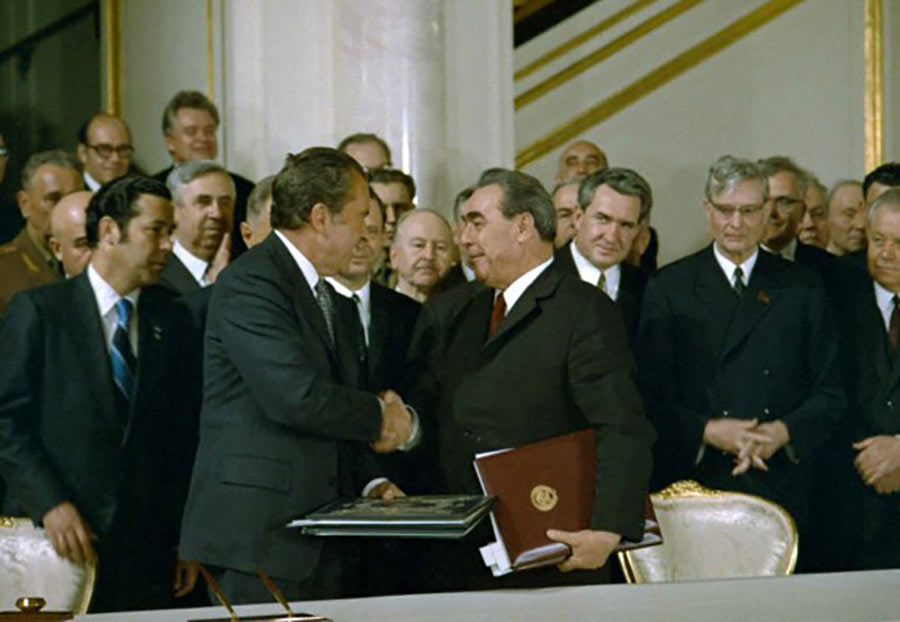By Marshall Garvey
Twenty two years after the collapse of the Soviet Union and the end of the Cold War, relations between the Obama Administration and Russia have regressed. Aside from hot-button issues like asylum for NSA leaker Edward Snowden and Russia’s anti-homosexuality law, Barack Obama and Vladimir Putin have not been able to come to terms over imminent diplomatic issues. The two leaders remain distant on critical policies such as missile defense and nuclear arsenal reductions, and while they were able to address Iran and North Korea, the ongoing Syrian conflict continues to drive another wedge between them. Seeing Russia’s support for President Bashar al-Assad, opposed to America’s support for the rebels, one can’t help but recall the chess-like battles for power across the globe during the Cold War.
As President, Richard Nixon greatly improved relations with the Soviet Union at a time when they couldn’t have been more strained. Aside from being in the middle of the Cold War, the two countries were less than a decade removed from the Cuban Missile Crisis, a standoff that put the world the closest it had ever been to a nuclear war. Although their nuclear weapons were removed from the Americas, the Soviet Union was still exercising its power throughout Europe. In 1968, the year Nixon was elected, Soviet Premier Leonid Brezhnev sent a military invasion to put down the Prague Spring uprising in Czechoslovakia, a movement that sought to break free of Soviet power.
Nonetheless, in his first inaugural address on January 20, 1969, President Nixon announced he was going to seek a lessening of tensions between the two superpowers. “After a period of confrontation, we are entering an era of negotiation,” he said. The policy became known as “detente,” a French term for the easing of strained relations.
President Nixon’s approach to relaxed tensions was a decisive success in the Cold War. As the first U.S. President to visit the Soviet Union, in June of 1972, the relationship Nixon established enabled him to broker the Strategic Arms Limitation Treaty (SALT) with Brezhnev. While negotiations had started in November of 1969, it was the 1972 visit that cemented the Anti-Ballistic Missile Treaty and a host of other agreements.
 President Nixon shaking hands with Brezhnev after the signing of SALT
President Nixon shaking hands with Brezhnev after the signing of SALT
The points of disagreement between Obama and Putin pale in comparison to the threats President Nixon navigated in order to have the SALT treaty signed. The crucial 1972 summit was nearly cancelled due to the accidental bombing of Soviet merchant ships at anchor in Haiphong Harbor in Vietnam. Brezhnev, outraged, refused to concede any ground in his support for the North Vietnamese, nor would he pressure them to agree to any negotiations. President Nixon, realizing the importance of reaching other crucial agendas, opted to focus on U.S.-Russia arms treaties instead of letting the Vietnam impasse potentially sabotage relations altogether.
Thanks to Nixon and Brezhnev’s ultimate success in Moscow, however, the two were able to realize further successful meetings. Brezhnev visited the U S. for another summit in June of 1973, joining Nixon at both Camp David and the president’s home in Casa Pacifica. He even presented the Soviet premier, an avid luxury car collector, with a new Lincoln Continental. Detente yielded constructive relations even after Nixon left office in 1974, including the first joint U.S.-Soviet space mission, Apollo-Soyuz, in the summer of 1975.
As the deteriorating relationship between the U.S. and Russia continues to impede key diplomatic goals, Nixon’s balanced but resolute use of detente serves as a road map for bridging even the most contentious divides.

